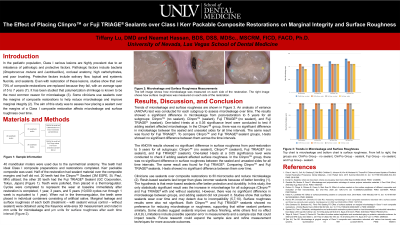Restorative
213 - Effect of Placing Sealant over Composite on Microleakage and Roughness

- TL
Tiffany Lu, DMD
Pediatric Dental Resident
University of Nevada, Las Vegas, NV
University of Nevada, Las Vegas School of Dental Medicine
Rowland Heights, California, United States - LR
Lee R. Roundy, Program Director, Pediatric Dentist
UNLV SDM Pediatric dental residency
Las Vegas, Nevada, United States
Presenting Author(s)
Program Director(s)
Purpose: The aim of this clinical trial was to assess how placing a sealant over the margins of a Class I composite restoration affects microleakage and surface roughness over time.
Methods: Forty extracted mandibular molars had Class I Premise packable composite restorations placed. The teeth were split into 2 groups – 20 in ClinProSealant and 20 in Fuji Triage sealant. Sealant was placed on half the restoration per tooth. Microleakage and surface roughness were measured post-restoration using the Keyence wide-area 3D measurement system. Teeth were placed in a thermocycler at 1, 3, and 5 weeks, representing clinical years. Values were measured at each interval and analyzed using analysis of variance (ANOVA) and t-test.
Results: For both ClinProSealant and Fuji Triage sealant groups, there were statistically significant increases (P < .05) in microleakage on both sides of the restorations (with and without the sealant) from post-restoration to 5 clinical years. For both groups, when comparing both sides at each time interval, the microleakage and surface roughness differences were not statistically significant (P >0.05). When comparing the effectiveness of the 2 sealant materials, there were no statistically significant differences (P >.05) in microleakage and surface roughness at all time intervals.
Conclusion: Though adding sealant over the margins of a composite restoration can fill in microcracks, this study shows there are no significant differences in microleakage and surface roughness compared to just doing a composite restoration by itself. Further research can be performed with a larger sample size to test for possible significant differences.
Identify Supporting Agency and Grant Number:

.jpg)